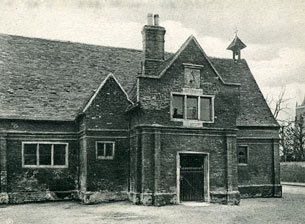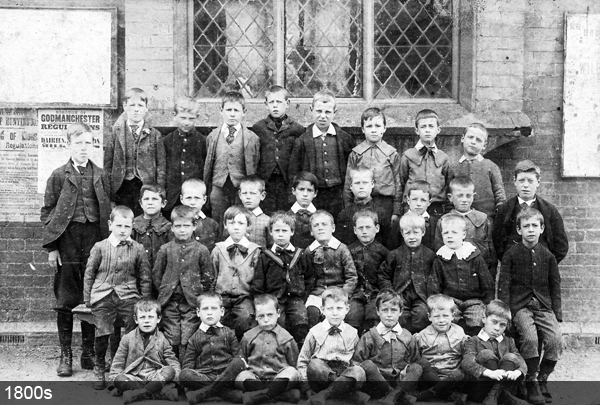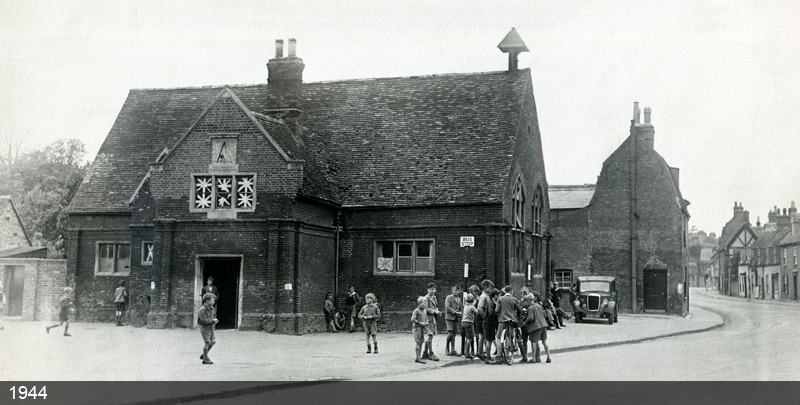Queen Elizabeth Grammar School Godmanchester
By Pam Sneath.
The school building sits in the heart of Godmanchester and is passed, often without notice, by many on their way to the Chinese Bridge and the recreation grounds and riverside walks beyond. Others know it well as a community hall where they or their children attend classes, clubs or parties. What is less understood about the building is the role it had for nearly 400 years as the town's grammar school.
The Shorter Oxford English Dictionary defines grammar school as 'a class of schools founded in the 16th century or earlier for the teaching of Latin Grammar'. It seems probable that some form of education had existed in Godmanchester long before the founding of the Queen Elizabeth Grammar School. There is evidence to suppose that a Chantry founded in the 14th century was also used for teaching purposes, but during the reign of Edward VI the endowment lapsed, passing into the hands of the king.
On the 20th of September 1558, at the very start of the reign of Queen Elizabeth I, a certain Richard Robins of the town of Godmanchester, 'being seeke of bodie but hole of mynde and parfite remembraunce' made his last will and testament. In it he willed that enough of his lands as necessary were to be sold to raise the rent or value of £20 per annum with which a Free Grammar School was to be endowed in Godmanchester under the supervision of a Cambridge College to be appointed by Thomas, Bishop of Lincoln. He further requested that the schoolmaster was to be a priest so that every Friday and Sunday mass could be said for amongst others, his own soul, the souls of his two deceased wives, his parents and 'all christian soules'. The school master and the scholars had to agree to keep all 'orders, statutes and rules' as set down by the Bishop. Shortly after making his will Richard Robins died, little knowing that legal complications were to result, continuing for nearly 30 years and only being settled when the case was brought before the Star Chamber.
'being seeke of bodie but hole of mynde and parfite remembraunce' made his last will and testament. In it he willed that enough of his lands as necessary were to be sold to raise the rent or value of £20 per annum with which a Free Grammar School was to be endowed in Godmanchester under the supervision of a Cambridge College to be appointed by Thomas, Bishop of Lincoln. He further requested that the schoolmaster was to be a priest so that every Friday and Sunday mass could be said for amongst others, his own soul, the souls of his two deceased wives, his parents and 'all christian soules'. The school master and the scholars had to agree to keep all 'orders, statutes and rules' as set down by the Bishop. Shortly after making his will Richard Robins died, little knowing that legal complications were to result, continuing for nearly 30 years and only being settled when the case was brought before the Star Chamber.
In May 1561, during a lull in the legal battle and at the request of the townspeople, Queen Elizabeth I issued letters-patent granting her name to the school. This is proudly born out by the inscription under the south porch window 'Eliz. Reg. Hujus Scholae Fundatrix'. The Queen's charter sets out that the education and instruction in Grammar were to be taught by one master and one usher, (also known as a sub-pedagogue or hypodidascal!) and that fourteen 'honest men of Godmanchester' and the vicar of the parish were to constitute the school governors.
The Grammar School in Godmanchester was one of 136 such schools founded in the reign of Queen Elizabeth I, reflecting a flourishing of educational establishments at this time. The grammar school was the entry gate to the professions and superior trades and occasionally a means of changing ones status in life. A notable example was Stephen Marshall, who became Chaplain to the House of Commons during the Civil War. Marshall was from a lowly background, the son of a Godmanchester glover, born around 1595. His family often depended for survival on the gleanings from the fields their children collected, so attendance at school would most likely have been irregular. Nevertheless he 'got as much Grammar learning as his poverty and industry would attain to' and while at school was probably influenced in his later spiritual development. He went on to study at Emmanuel College, Cambridge, a hotbed for budding Puritan preachers, whose masters and fellows were responsible for appointing the Godmanchester schoolmaster.
The emphasis on teaching grammar did not last for long. By the end of the 17th century there appeared to be a growing pressure for more utilitarian subjects to be taught, coupled with a decline in grammar schools after the Civil War, especially in East Anglia. How long Latin grammar was taught at the school in Godmanchester is unknown, but in 1704 a report of the governors' meeting states that teaching consisted of learning to 'write and cast accounts'. A William Lemon was appointed as schoolmaster, (after being presented and examined by the Bishop) and a William Cole as usher. The latter being paid fifty shillings out of the rents. It appears that grammar was not the only thing to suffer; the master and his usher were to be on duty only two days a week, Wednesdays and Fridays from 9.00 to 11.00 am and from 1.00 to 3.00 pm.
School life must have been something of an ordeal to many boys brought up to work outside with their hands. A weekly timetable exists from 1831 when a certain Mr Gaunt was the schoolmaster. Each day started with Bible Lessons, but the educational emphasis was on being able to read, write, spell and to have an understanding of basic arithmetic. The Catechism was also taught as set down by the Governors' Regulations of 1693. Lessons for the younger pupils appear to be an afterthought judging by the footnote: 'The lesser Boys Reading, Spelling, Catichisms, and Writing on Slates those who are Capable'. Dr. Fox, a local historian, recorded that there were 60 boys attending the school at that time and Mr Gaunt's salary had increased from £20 a year to £40 by an annual donation from Henry Sweeting the Borough Recorder. F.W. Bird, the Borough Treasurer, gives a vivid description of Mr Gaunt whose name seemed very apt: a small stooped, slimly-built man, dressed in black with a top-hat and spectacles on his nose and often a quill pen behind his ear. He was famous for his canings, the results of which could be heard for some distance; if a boy tried to escape, Mr Gaunt would run out after him. Mr Hopkins, who started teaching at the school in 1878, commented that the schoolwork was in a very backward state, the discipline very bad and the boys exceedingly rough, though Bird thought 'it served its time and generation well, and I know some boys who were educated within its walls occupy some good positions in after life'; this was apparently achieved despite local assertions that a grammar book was never seen there!
Attendance was a continual problem in an agricultural community where duties on the land took precedence. The entry for June 26th 1882 in the school log book records: 'miserable attendance - great number of boys away haymaking, many unqualified to go to work' and on April 29th 1884: 'a few boys are away to gather cowslips'. Concentration must have been difficult in the extreme at times. On 24th May 1882 the master reports: 'we have had a very noisy time in school today owing to the presence of two traction engines against the windows and the washing of some hundreds of sheep on the School Hill' and on 19th June teaching was almost impossible due to the noise from swinging boats, toy and sweet stalls and several vans on School Hill.
It is difficult to know what the inside of the Grammar School looked like before the early 19th century. There is no information available in archival material to help interpret the way the space within the school building was arranged. The porch appears to be the best preserved part of the interior. The Royal Commission on Historic Monuments confirms that the inner doorway of the porch is original and that the door is partly restored. Any mention of what is known as the 'headmaster's window' above the internal entrance to the porch is omitted by the Royal Commission and there does not appear to be any reference to it in archival sources, nevertheless it is a feature of the school which attracts much interest. It is recorded in the early part of the 19th century, that the schoolmaster lived in part of the school building, probably the west end and including the porch which contains a cast-iron fireplace the chimney stack to which may be seen over the porch roof.
A good deal of the original red Tudor brick work survives in the external walls which gives a clear indication of the school's original dimensions. It would appear to be the case that red bricks were used instead of those made from the local yellow clay, to impart a sense of status and pride in the Godmanchester Grammar School and to mark it out in a distinctive manner from other vernacular buildings in the town.
Probably the biggest change to the school building occurred around the turn of the 20th century when a new classroom was added to the north side. Several alterations to modernise the school were carried out before the Second World War. In 1922 a folding partition was fixed in the large, front classroom to divide it into two, making three classrooms in all. In 1933 electric lighting was installed and in 1936 a drinking fountain was provided in the yard against the west wall of the school. In 1940 contingency plans for fire fighting involved informing 'the headmaster to make full use of the stirrup pump and other apparatus provided by the Local Education Authority'. Despite attempts to bring the school and its facilities up to date immediately after the Second World War, the school building was becoming difficult to sustain.
In June 1946 the National School Survey gave a bad report on the building's general state of repair. Possibly as a response to this report it was recorded in the Governors' Minute Book the same month:
'The Boys' School is in many ways unsuitable for its purpose by modern standards, and especially is unsafe on account of its position and the absence of suitable playground accommodation'.
The Huntingdonshire Education Authority proposed to move boys over eleven years of age to a new secondary school in Huntingdon and those under eleven would be transferred to the existing council school for girls in Godmanchester which would then become a Junior Mixed Primary School. After almost four centuries the school vacated the premises at the end of May 1948.